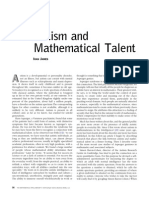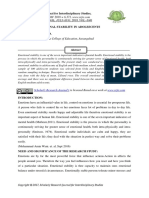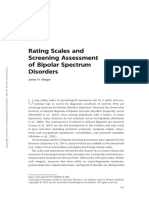Sataq 3R
Sataq 3R
Uploaded by
j01008133Copyright:
Available Formats
Sataq 3R
Sataq 3R
Uploaded by
j01008133Original Title
Copyright
Available Formats
Share this document
Did you find this document useful?
Is this content inappropriate?
Copyright:
Available Formats
Sataq 3R
Sataq 3R
Uploaded by
j01008133Copyright:
Available Formats
he SATAQ-3R (Sociocultural Attitudes Towards Appearance Questionnaire - Revised version 3) is an
T
updated version of the original SATAQ developed by Thompson, van den Berg, Roehrig, Guarda, and
Heinberg. It is designed to assess individuals' perceptions and internalization of societal attitudes and
pressures related to appearance, specifically body shape and weight.
The SATAQ-3R includes several subscales that focus on different dimensions of sociocultural attitudes
towards appearance, similar to previous versions of the questionnaire. These subscales typically include:
● Internalization: Measures the degree to which individualsinternalize societal
standards of attractiveness and incorporate them into their self-concept.
● Pressures: Assesses the perceived pressure fromvarious sources, such as
media, peers, and family, to conform to societal standards of appearance.
● Information: Evaluates exposure to societal messagesand information about
appearance from different sources, including media, advertising, and interpersonal interactions.
● Awareness: Measures individuals' awareness of societalstandards and
expectations regarding appearance.
he SATAQ-3R consists of multiple items within each subscale. Respondents are asked to rate their level
T
of agreement with each item on a Likert-type scale, typically ranging from strongly disagree to strongly
agree.
The SATAQ-3R is widely used in research and clinical settings to explore the impact of sociocultural
factors on body image, eating behaviors, and psychological well-being. It helps researchers and clinicians
understand how societal norms and pressures related to appearance influence individuals' attitudes,
beliefs, and behaviors.
By examining SATAQ-3R scores, researchers and clinicians can gain insights into the ways in which
societal influences contribute to body dissatisfaction, disordered eating patterns, and other body image
concerns. This information can inform interventions and prevention efforts aimed at promoting positive
body image and reducing the negative impact of sociocultural pressures on individuals' mental health.
You might also like
- Dax PDFDocument3 pagesDax PDFmatildrakhel100% (1)
- The Internalized Shame Scale: Temporal Stability, Internal Consistency, and Principal Components AnalysisDocument9 pagesThe Internalized Shame Scale: Temporal Stability, Internal Consistency, and Principal Components AnalysisVornicu Tatian100% (1)
- SWAP-200 ClassificaçãoDocument12 pagesSWAP-200 ClassificaçãoJéssica De Oliveira ViveirosNo ratings yet
- 13 Item Shyness Scale The Revised Cheek and Buss Shyness ScaleDocument2 pages13 Item Shyness Scale The Revised Cheek and Buss Shyness Scalekenneth80% (5)
- Amato Divorce Review JMF June10Document17 pagesAmato Divorce Review JMF June10kdial40No ratings yet
- Eysenck Personality Questionnaire - Revised (Epq-R)Document7 pagesEysenck Personality Questionnaire - Revised (Epq-R)Neha FloryNo ratings yet
- PWB Ryff 1995Document9 pagesPWB Ryff 1995resti ayuNo ratings yet
- The Gratitude Questionnaire-Six Item Form (GQ-6)Document1 pageThe Gratitude Questionnaire-Six Item Form (GQ-6)Paula DenisaNo ratings yet
- Paternal Depression in The Postnatal PeriodDocument6 pagesPaternal Depression in The Postnatal PeriodBrandon GrayNo ratings yet
- Interpersonal Support Evaluation List (ISEL) : ReferenceDocument6 pagesInterpersonal Support Evaluation List (ISEL) : ReferenceAndreea AlexandraNo ratings yet
- Stanford Binet Intelligent Scales For Early ChildhoodDocument24 pagesStanford Binet Intelligent Scales For Early ChildhoodAayushi ShrivastavaNo ratings yet
- Ryan, Epstein, Keitner - The McMaster Model of Family FunctioningDocument21 pagesRyan, Epstein, Keitner - The McMaster Model of Family FunctioningGabriella StrámaNo ratings yet
- Child Is A Discouraged Child," and That Children's Behavior Patterns Improve MostDocument7 pagesChild Is A Discouraged Child," and That Children's Behavior Patterns Improve MostMaleeka PrettyNo ratings yet
- Teaching Anxiety Amongst Hong Kong and Shanghai In-Service Teachers: The Impact of Trait Anxiety and Self-EsteemDocument15 pagesTeaching Anxiety Amongst Hong Kong and Shanghai In-Service Teachers: The Impact of Trait Anxiety and Self-Esteemluiza bndlnNo ratings yet
- JDQ Scale PDFDocument34 pagesJDQ Scale PDFTeguh Lesmana100% (1)
- 6 DepressionDocument42 pages6 DepressionEIorgaNo ratings yet
- A Study of Academic Achievement of Adolescents in Relation To Family ClimateDocument7 pagesA Study of Academic Achievement of Adolescents in Relation To Family ClimateAnonymous CwJeBCAXpNo ratings yet
- From A Novice To An Expert IELTS Reading Answers With ExplanationDocument6 pagesFrom A Novice To An Expert IELTS Reading Answers With ExplanationLee LouiseNo ratings yet
- Lai-Oei2014 Article CopingInParentsAndCaregiversOf PDFDocument18 pagesLai-Oei2014 Article CopingInParentsAndCaregiversOf PDFandrea lopezNo ratings yet
- R01 - Salovey 1986 - The Differentiation of Social-Comparison Jealousy & Romantic JealousyDocument13 pagesR01 - Salovey 1986 - The Differentiation of Social-Comparison Jealousy & Romantic JealousyGrupa5No ratings yet
- cLINICAL dEMENTIA rATING WORKSHEETDocument10 pagescLINICAL dEMENTIA rATING WORKSHEETFana Ștefania DucaNo ratings yet
- Eating Disorders National Institute of Mental Health's PerspectiveDocument13 pagesEating Disorders National Institute of Mental Health's PerspectivelinhamarquesNo ratings yet
- Please Find Below And/or Attached An Office Communication Concerning This Application or ProceedingDocument8 pagesPlease Find Below And/or Attached An Office Communication Concerning This Application or ProceedingJohn WhitakerNo ratings yet
- Perfectionism, Loneliness and Life Satisfaction in Engineering StudentsDocument17 pagesPerfectionism, Loneliness and Life Satisfaction in Engineering StudentsMariaNo ratings yet
- Autism and Math TalentDocument3 pagesAutism and Math TalentNafisah Baharom100% (1)
- Confusion and Introjection A Model For Understanding The Defensive Structures of The Parent and Child Ego States PDFDocument14 pagesConfusion and Introjection A Model For Understanding The Defensive Structures of The Parent and Child Ego States PDFUrosNo ratings yet
- Anxiety ScaleDocument19 pagesAnxiety Scaleandreea gheorgheNo ratings yet
- Influence of Father Involvement On Psychological Well-Being and Academic Performance ofDocument23 pagesInfluence of Father Involvement On Psychological Well-Being and Academic Performance ofChandilNo ratings yet
- 3.1 Emotional ScaleDocument3 pages3.1 Emotional Scaleionut307No ratings yet
- Locus of ControlDocument6 pagesLocus of ControlNidzicine DzidzabidziceNo ratings yet
- REBT Education KnausDocument146 pagesREBT Education KnausmarineanuNo ratings yet
- S6 Emotion Regulation StrategiesDocument4 pagesS6 Emotion Regulation StrategiesRăzvan-Andrei ZaicaNo ratings yet
- 03 1 AlbuDocument16 pages03 1 AlbuEvy PopNo ratings yet
- Barber 1996Document31 pagesBarber 1996MorganNo ratings yet
- A Study of Marital Conflict On Measures of Social Support and Mental HealthDocument14 pagesA Study of Marital Conflict On Measures of Social Support and Mental HealthSunway UniversityNo ratings yet
- Exploring Emotional Stability in AdolescentsDocument5 pagesExploring Emotional Stability in AdolescentsAnonymous CwJeBCAXpNo ratings yet
- When Caring Hurts: The Silence Burnout of SonographersDocument5 pagesWhen Caring Hurts: The Silence Burnout of SonographersCarlos BarradasNo ratings yet
- Neopir CaietDocument9 pagesNeopir CaietAncaNo ratings yet
- Dumitrescu Rusu 2012Document15 pagesDumitrescu Rusu 2012Eduardo BrentanoNo ratings yet
- Hans J Eysenck and Raymond B Cattell On Inte 2016 Personality and IndividuDocument8 pagesHans J Eysenck and Raymond B Cattell On Inte 2016 Personality and IndividuPaula CelsieNo ratings yet
- UytDocument14 pagesUytdoina cricimaruNo ratings yet
- The Experiences in Close Relationship Scale (ECR) - Short Form: Reliability, Validity, and Factor StructureDocument18 pagesThe Experiences in Close Relationship Scale (ECR) - Short Form: Reliability, Validity, and Factor Structurelobont nataliaNo ratings yet
- Schutte 1998Document11 pagesSchutte 1998Anca OPREANo ratings yet
- Pastas TraitDocument2 pagesPastas TraitnalaNo ratings yet
- 2023-64400-008 BipolarDocument16 pages2023-64400-008 BipolarLuciana OliveiraNo ratings yet
- A015 CopilulsimptomatologieDocument21 pagesA015 CopilulsimptomatologieOana VezanNo ratings yet
- Psychodiagnostics and Psychological AssessmentDocument4 pagesPsychodiagnostics and Psychological AssessmentBim arra0% (1)
- 40 OrganizareDocument1 page40 OrganizareDorin TriffNo ratings yet
- Notes: Customer EmotionsDocument2 pagesNotes: Customer EmotionsNageshwar YadavNo ratings yet
- Joachim Stoeber, (Ed) - The Psychology of Perfectionism - Theory, Research, Applications (2018) - RemovedDocument24 pagesJoachim Stoeber, (Ed) - The Psychology of Perfectionism - Theory, Research, Applications (2018) - Removedflorencia rubioNo ratings yet
- Child PTSD Symptom ScaleDocument4 pagesChild PTSD Symptom ScaleKrol Amafo100% (1)
- Conners Et Al (1998b)Document13 pagesConners Et Al (1998b)Rute Almeida RomãoNo ratings yet
- Acceptance and Commitment Therapy For ChildrenDocument53 pagesAcceptance and Commitment Therapy For ChildrenClaudiaNo ratings yet
- GDS - Global Deterioration ScaleDocument1 pageGDS - Global Deterioration ScaleJose Alejandro Ramirez ReyesNo ratings yet
- Epq-R (Forma Scurta)Document9 pagesEpq-R (Forma Scurta)minodoraNo ratings yet
- Assignment Research Social Media Impact On Mental HealthDocument5 pagesAssignment Research Social Media Impact On Mental Healthnaseer buttNo ratings yet
- Adobe Scan 12-Mar-2024Document4 pagesAdobe Scan 12-Mar-2024JASPREET KAURNo ratings yet
- CONCEPTDocument5 pagesCONCEPTsolisjesse85No ratings yet
- The Sociocultural Attitudes Towards AppearanceDocument12 pagesThe Sociocultural Attitudes Towards AppearanceAndrea Luna CovarrubiasNo ratings yet
- Thesis Detail NotesDocument7 pagesThesis Detail Notesayeshatahir7333No ratings yet



























































